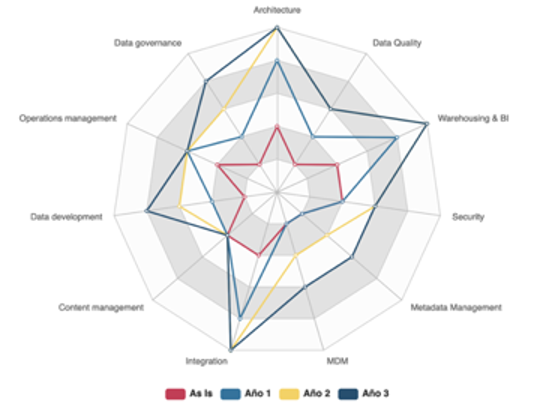We are increasingly aware of the technological capabilities available in the market; however, we often struggle to extract value from data. Hence, it is essential to follow a methodology that uncovers the value of data, starting with a Data Governance model.
Your company may possess a vast amount of data from its processes, customers, or suppliers, which remains stored awaiting final use. The problem arises when accessing it becomes difficult due to uncertainty about its location or how to consume it efficiently.
Within this information, you may find a treasure trove, whether it’s new business models or increased profitability for your company.
The most common way to leverage data is by analyzing it to improve your business. However, this approach carries risks: decision-making may become slow, or you may encounter outdated or hidden data.
Hence, the best way to mitigate this risk is by adopting good Data Governance practices.
Data Governance enables you to turn data into a company asset by obtaining executive support, typically aimed at solving a specific problem. It also requires reviewing the company’s current state regarding its processes and data.
Challenges of Data Governance
Data Governance is not a project but a new area for the company, which poses numerous challenges:
Challenge of Building a Roadmap for Implementing the Data Governance Area
There are various sources to consult to define a data governance methodology, where the Data Management Association (DAMA) or IBM Governance Council can serve as good references. Regardless of the methodological selection, the current maturity level of each of the pillars or dimensions should be defined, along with the level required concerning the company’s strategies and goals. This helps to understand the gap that needs to be filled and the amount of work required. At the end of this task, a graph like this should be produced:
Challenge of Generating Early Wins

The results of a data governance area do not come as quickly as one would like. This involves building the business glossary, creating the data catalog, structuring infrastructures, among others. The order in which each of the pillars or dimensions of data governance is addressed is crucial and should be based on business needs with the greatest impact but requiring the least effort. Governed self-service BI can yield good results, as can Master Data Management (MDM) initiatives that allow for the construction of a single truth regarding organizational data.
Challenge of Having Data Quality
After acquiring storage and data processing capabilities, ensuring data quality becomes the primary challenge for companies. Quality is one of the most relevant factors in its use. This is not about meeting a global standard but rather requires an analysis of context and objectives to define accuracy, integrity, timeliness, relevance, coherence, reliability, presentation, and availability requirements.
Challenge of Defining and Implementing the Right Architecture
To achieve business objectives leveraged on data, it is necessary to have adequate infrastructure for these needs:
- Large volume of data
- Structured and unstructured information
- High availability of information
In this regard, for any organization needing to organize its data, it is essential to know where this data comes from and what its ultimate purpose is. Implementing a Data Governance Model is necessary, not only to meet current needs but also to protect the company.
Get in Touch with Us
Therefore, if you wish to implement this process in your company, we invite you to contact us to assist you in designing a model that fits your company. Email us at comunicaciones@bpt.com.co or leave your details in the contact form.


